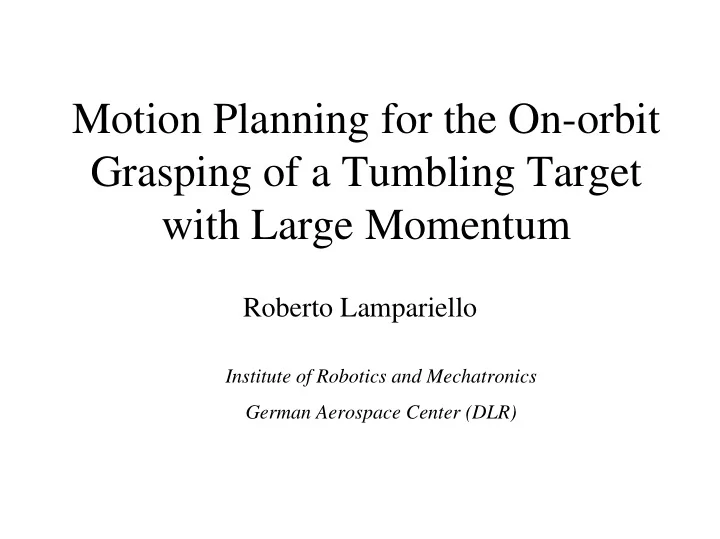

Motion Planning for the On-orbit Grasping of a Tumbling Target with Large Momentum Roberto Lampariello Institute of Robotics and Mechatronics German Aerospace Center (DLR)
Contents • Some Past and Current Space Programs • Free-flying robots and related problems • Motion Planning for Grasping a Tumbling Target • Other applications • Conclusion Institute of Robotics and Mechatronics, DLR MOVIE Date: 08/01/2005 2
Past and Current Space Programs • ETS-VII – NASDA • Workshop on On-orbit Servicing of Space Infrastructure Elements Via Automation & Robotics Technology: “Developing a Roadmap” • Orbital Recovery – ConeXpress • TECSAS Institute of Robotics and Mechatronics, DLR MOVIE Date: 08/01/2005 3
TECSAS -Technology Satellite for demonstration and Verification of Space Systems Target spinning axis ( ω = 4 deg/sec) Target satellite ≈ m m TARGET CHASER Manipulator Sarah hand Handle (7 D.O.F.) (CSA) Chaser satellite (thruster controlled) Institute of Robotics and Mechatronics, DLR MOVIE Date: 08/01/2005 4
Free-flying robot dynamics and related problems • free-floating dynamics • free-floating vs. free-flying • optimal minimum may be the free-floating solution but this is a priori unknown Institute of Robotics and Mechatronics, DLR MOVIE Date: 08/01/2005 5
Free-flying robot dynamics and related problems (2) • dynamic coupling - potential collision • external actions vs. uncertainty – require identification • path planning solutions are inertial parameter dependent Non-expert Semi-expert Planned Institute of Robotics and Mechatronics, DLR MOVIE Date: 08/01/2005 6
Algorithm (Lampariello, Agrawal – ICRA ‘03) Motivation : A free-flying robot is generally subject to: • spacecraft control actions • orbital disturbances (gravity gradient, orbital dynamics) • as well as robot torques Free-floating approximation is only valid for: • local motions or short operations Require an efficient planner Institute of Robotics and Mechatronics, DLR MOVIE Date: 08/01/2005 7
Problem Definition • Path planning for actuated as well as for non- actuated spacecraft degrees of freedom • Optimal solution for minimal energy • Fast solutions for realistic applications • Dynamically feasible solutions • Point-to-point maneuvers of the robot end-effector and grasping maneuvers for a moving target Institute of Robotics and Mechatronics, DLR MOVIE Date: 08/01/2005 8
Algorithm Methodology • Spatial model of free-flying robot • Initial and final end-effector state defined in inertial space or a given target motion • Final robot configuration unknown & optimized (no BVP!) • Single shooting optimization problem • Motion planning in joint space for avoidance of dynamic singularity problem Institute of Robotics and Mechatronics, DLR MOVIE Date: 08/01/2005 9
Equations of motion - fully actuated system State space variables: Kinematics: Dynamics: Institute of Robotics and Mechatronics, DLR MOVIE Date: 08/01/2005 10
Modeling - rheonomic joints Let state space variables be: and rheonomically driven variables: New equations: • is dependent on , a prescribed function of time • order of equations = 6 - d.o.f.s of base body • Free-floating system: Institute of Robotics and Mechatronics, DLR MOVIE Date: 08/01/2005 11
Trajectory Planning - optimization problem: point-to-point • Equality constraints: initial and final end-effector position and orientation: ( kinematics ) • Inequality constraints: ( inverse dynamics ) • Cost function: ( base actuation ) Institute of Robotics and Mechatronics, DLR MOVIE Date: 08/01/2005 12
Use of Free-floating solution • Local workspace - workspace with no base → actuation free-floating solution = from integration of equations of motion • Global workspace - all reachable free space → free-flying solution = free-floating solution + extra parametric function of base states Institute of Robotics and Mechatronics, DLR MOVIE Date: 08/01/2005 13
Trajectory Planning Solver Optimization problem: for - one free parameter for each state variable Parameterization of state variables: E.g. base position free-floating solution + polynomial order 5 Parameters: Institute of Robotics and Mechatronics, DLR MOVIE Date: 08/01/2005 14
Results - Path in local workspace • Initial state: • Desired final state: • Cost: 8e-3 kg m/s • Computational time ~ 5-7 seconds • Initial guess: Institute of Robotics and Mechatronics, DLR MOVIE Date: 08/01/2005 15
Results - Path in global workspace • Desired final state: • Cost: 4460 kg m/s (1815 kg m/s for translational forces) • Computational time ~ 10 seconds • Initial guess: as previous Institute of Robotics and Mechatronics, DLR MOVIE Date: 08/01/2005 16
Motion Planning for Grasping a Tumbling Target Institute of Robotics and Mechatronics, DLR MOVIE Date: 08/01/2005 17
Motion Planning for Grasping a Tumbling Target (2) Three phases: • Approach to target • Tracking of grasping point – inverse kinematics • Grasping and stabilization Inequality constraints: • As previously for the point-to-point problem • Inequality constraints on chaser satellite states ( collision avoidance ) and end-effector forces • Same cost function ( base actuation ) Institute of Robotics and Mechatronics, DLR MOVIE Date: 08/01/2005 18
Motion Planning for Grasping a Tumbling Target (3) Motivation for path planning: • due to free-floating state, need to guarantee no collision • due to tracking phase for minimum impact, need to guarantee feasibility of solution (joint limits, singularities, etc.) • due to large momentum, need to guarantee stabilization of residual motion • can optimize for safety (initial chaser attitude and robot configuration, chaser actuation, etc.) → need a realistic model Institute of Robotics and Mechatronics, DLR MOVIE Date: 08/01/2005 19
Motion Planning for Grasping a Tumbling Target (4) Institute of Robotics and Mechatronics, DLR MOVIE Date: 08/01/2005 20
Other Applications – Parameter Identification • Modeling requirements • Experimental design ETS-VII Experimental Data Institute of Robotics and Mechatronics, DLR MOVIE Date: 08/01/2005 21
Other Applications Compensation Maneuvers for a 2D platform Institute of Robotics and Mechatronics, DLR MOVIE Date: 08/01/2005 22
Conclusion - Problems and Demands • Path planning method provides optimal solutions for maneuvers in local and global workspaces but is highly nonlinear • Collision avoidance and improve algorithm efficiency • Integral modeling environment for all mentioned functionalities • Motion planning problems are diverse and model- based. Institute of Robotics and Mechatronics, DLR MOVIE Date: 08/01/2005 23
Thank you! Institute of Robotics and Mechatronics, DLR MOVIE Date: 08/01/2005 24
Recommend
More recommend